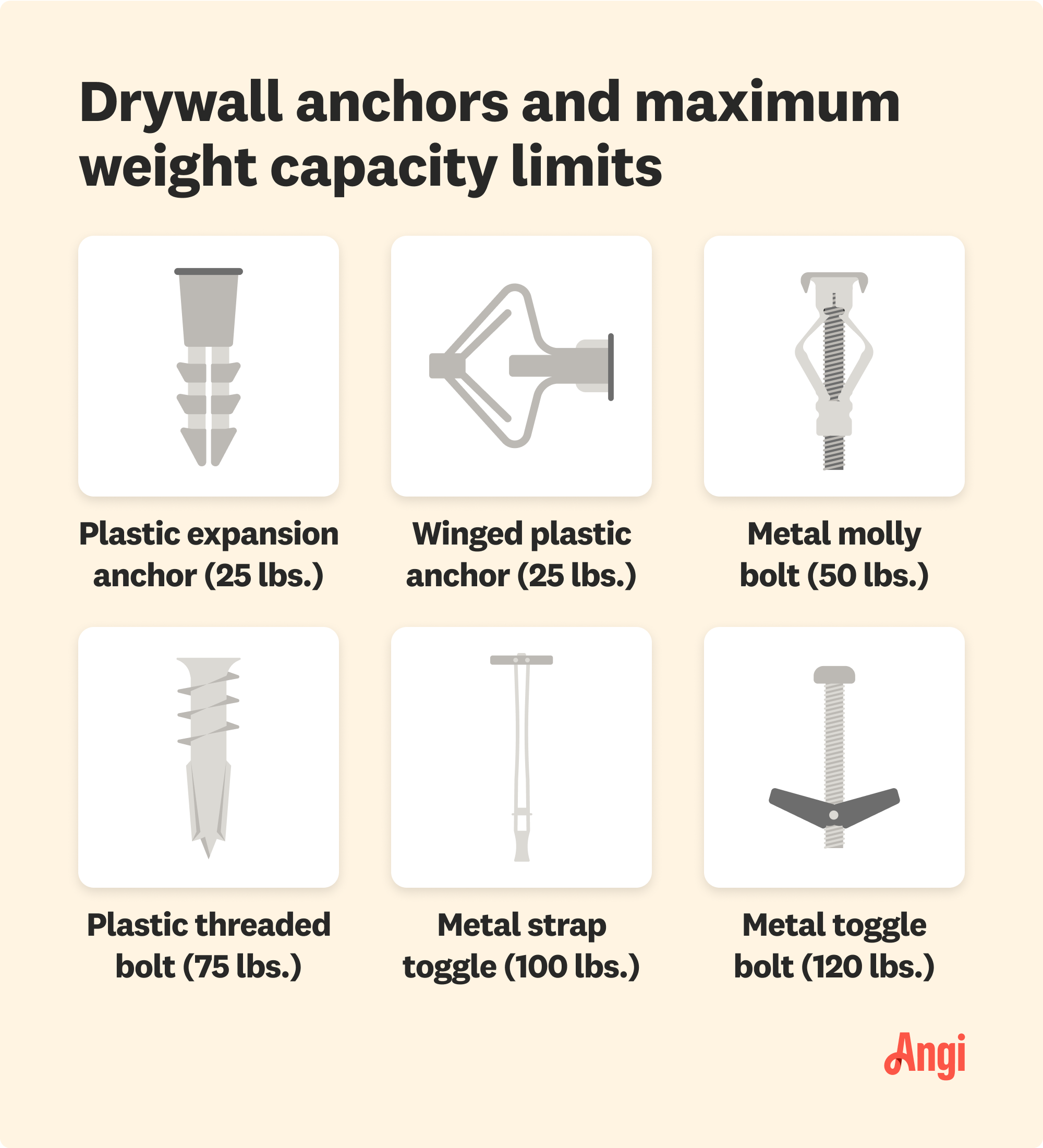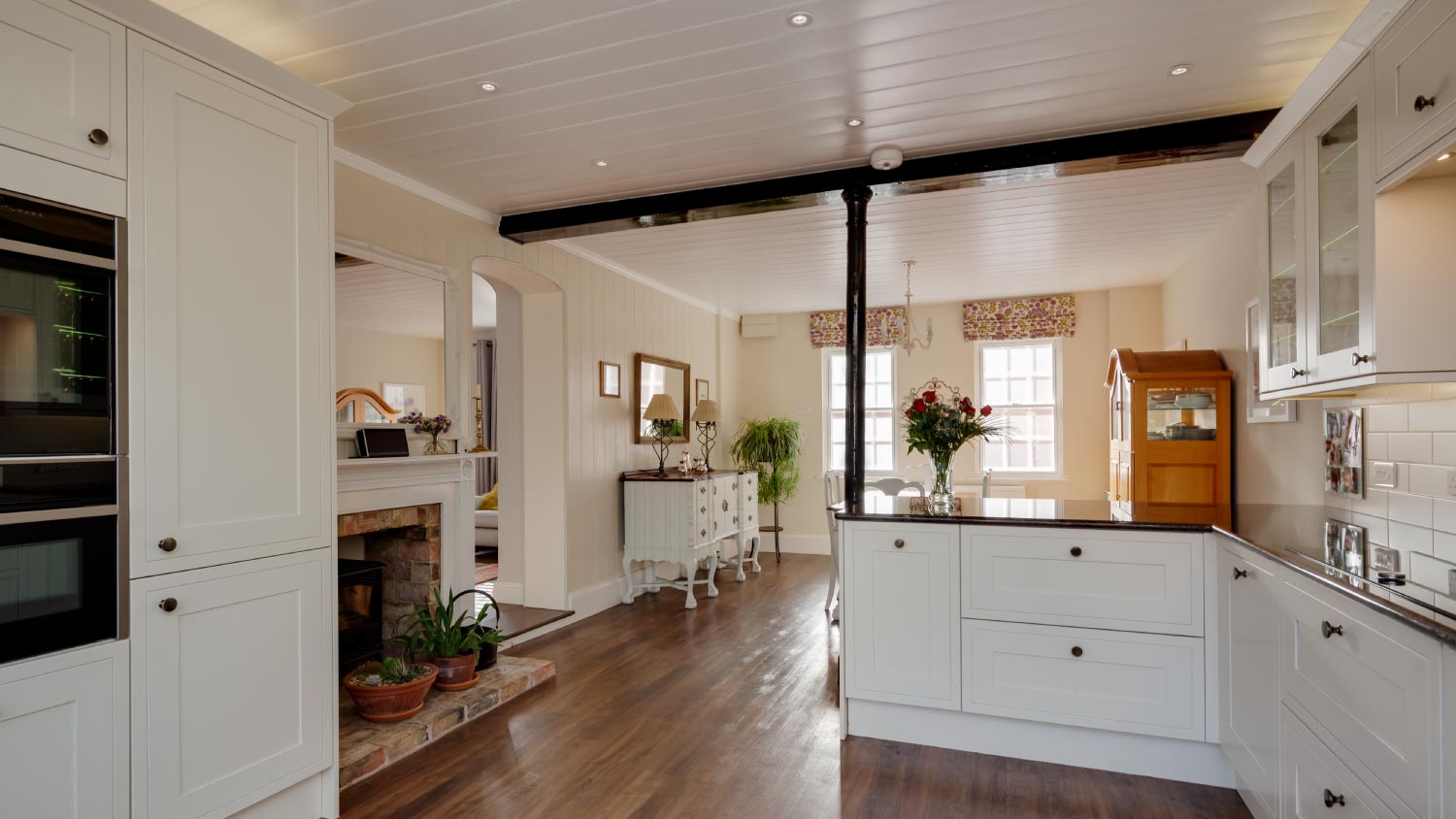
Pre-drywall inspection costs vary depending on the home size, build complexity, and reporting you receive. Estimate your budget with this cost guide.
It’s time to upgrade from thumbtacks


You finally figured out where to hang up that vintage mirror you’ve been holding on to—now you just need to figure out how.
The safest way to hang a heavy fixture on the wall is by attaching a nail into a wall stud. But, there are ways around it if the spot you want to hang your fixture doesn’t have a stud. All you need is a drywall anchor, a hammer, a drill, and a screw.
Before you start drilling, you need to decide which type of anchor you want to use. Drywall is mostly the same, so you’ll start the prepping process by determining the size of the item you want to hang. Use the table below to determine the best type of anchor for the item’s weight.

Know that if you choose an easier-to-install or less-expensive anchor that’s not right for the load you’re hanging, you could damage your drywall and the item you were hanging. Another important step is to use a stud finder to make sure you don’t drill a drywall anchor into a support structure.

Once you select your anchor type, measure the point where you will drill. Usually this will be two anchors that must be level. Use a laser level, if you have one, but you can also use a bubble level if the anchors will be spaced pretty close to each other.
To make sure the height is where you want to hang whatever you’re trying to hang, ask a friend to hold the item on the wall while you step back and view it. Once the item is in place and you’ve measured the exact distance between the holes, mark the drill spot on the wall with a pen or pencil.

Most drywall anchors require pilot holes. On the box of the drywall anchors, it should specify the size of the pilot hole you’ll need to drill before you can insert the anchor. Use an electric drill and a sharp drill bit, pressing just enough to engage the drill bit into the drywall. It’s advisable to use a mask and eye protection at this stage as drywall dust can be dangerous if inhaled.
Drill just deep enough that you make a hole through the other side of the drywall. We don’t always know what’s behind it so don’t press too hard when drilling in case you puncture another wall or hit something like a pipe or electrical wire. Once the pilot holes are drilled, clean them out by lightly blowing through the hole with a plastic tube.

Certain types of anchors—like toggle bolts and strap toggles—will require you to thread the anchor through the pilot hole until it reaches the back of the drywall. Once they have been threaded through, gently turn them with a screwdriver until they’re snug against the wall. Depending on the size of the pilot hole required, some anchors may require some light taps with a hammer but again, be careful not to damage the drywall by using too much force.

Other than the threaded anchors, the strength of the anchor comes from its expansion either within the pilot hole or by expanding against the back of the drywall. Once the pilot holes have been drilled (if necessary) and the anchor is inserted, insert the screws into the anchor. Drill them in enough that they activate the anchor. For threaded anchors, you just drill the screw into the anchor as there isn’t any expansion.
Usually, you will drill them in almost all of the way. It may seem like a good idea to leave more of the screw exposed so it’s easier to hang items, but you risk compromising the strength of the anchor.
You don’t want to risk damaging your item by hanging it right away. For lighter items—under 20 pounds—you can simply tug hard on the anchor. If it holds, you should be good to hang your item. For heavier items, try hanging the item itself but keep a hold of it. You want to slowly let the weight of the item rest on the anchor.
Once you’re sure it will hold the weight of your item, you can let go. It’s best to be careful and deliberate at this stage, as ripping out a drywall anchor will do real damage to the drywall, and since the hole will be compromised, you’ll have to patch the hole you just created, and start the process over.
Though drilling a drywall anchor is a relatively easy DIY, it is easy to make mistakes. It’s important to carefully read all manufacturer’s instructions that come with your anchors before you drill. Most importantly, triple check the required drill size before drilling your pilot hole.
Simple mistakes can happen to even the most experienced DIYers, so don’t fret. There are solutions and troubleshooting methods you can try.
If you drilled a pilot hole that is too big to securely hold a drywall anchor, there are a few things you can do:
Insert the anchor and fill the surrounding space with construction-grade adhesive.
Patch up the hole and find a new spot.
Purchase a new wall anchor the same size as your pilot hole.
There are some drywall anchor options that come in various lengths depending on the width of your drywall layer, so you will need to know that measurement in advance.
You can measure the thickness of your drywall by locating a stud behind the wall where you’ll install the anchor.
Once located, push a small hex key into the drywall until it touches the stud. Grip your fingers around the hex key where it meets the drywall surface and pull it out.
Measure the length between your fingers and the tip of the hex key to know how thick your drywall is.
An anchor breaking isn’t uncommon, especially if it wasn’t inserted correctly. Other times, specifically with a plastic anchor, it could have been compromised before it was installed. If an anchor breaks clean off the wall and you can remove it, simply pull it out with pliers.
However, sometimes an anchor breaks off in a way that leaves it flush with the wall but it remains tight in the pilot hole. You won’t be able to remove it easily. In this case, you have a few options you can try:
Patch over the hole and anchor with joint compound.
Remove the anchor by screwing through it and pulling it out of the wall.
Sometimes, you can insert an anchor directly into the broken piece.
You have some options but most of the time the best move is to remove the anchor by drilling it out, patching the hole, and starting the process over with a new, undamaged anchor.
Installing drywall anchors is an excellent DIY project. It requires a few tools and doesn’t take too much time. There is minimal mess, and no special skills are necessary. Even though the process is straightforward, if you do DIY, you need to pay careful attention to your work. Incorrectly installing an anchor can result in damage to both your wall and whatever you hang on the anchor.
In some cases, hiring a professional may make sense. A professional can do the job quickly and correctly—especially if it requires a ladder, or if your home has a complicated layout. Most jobs shouldn’t cost more than $100. The materials you will need are inexpensive and the cost of labor should be low, as a pro can complete this job quickly.
Very customer friendly. Lawn never looked bettet
On time very efficient. I feel safe and secure now.
Felipe called within 10 minutes of my request. He came the next morning, looked at the job, and gave me an estimate. He was able to come do the drywall repair within a couple of days and showed up right on time. He completed the job on time and did a great work. He is friendly, hard working,...
From average costs to expert advice, get all the answers you need to get your job done.

Pre-drywall inspection costs vary depending on the home size, build complexity, and reporting you receive. Estimate your budget with this cost guide.

Skim coating drywall is a great alternative to replacement, and is often more affordable. Use this guide to estimate the cost to skim coat walls in your home.

Installing beadboard ceilings is a great DIY project. Learn what to expect cost-wise from this project, whether removing or covering a popcorn ceiling.

What size drywall screws you should use depends on the thickness of your drywall and the stud material. This guide can help you choose the perfect match.

Hiring a drywall contractor to patch up a wall after plumbing or electrical work is your best bet to guarantee a smooth, clean finish. Finding a pro that’ll do a good job involves getting multiple quotes, plus checking references and qualifications.

Looking for the best moisture-resistant drywall for your next home project? Compare purple drywall vs. green drywall to narrow down your search.